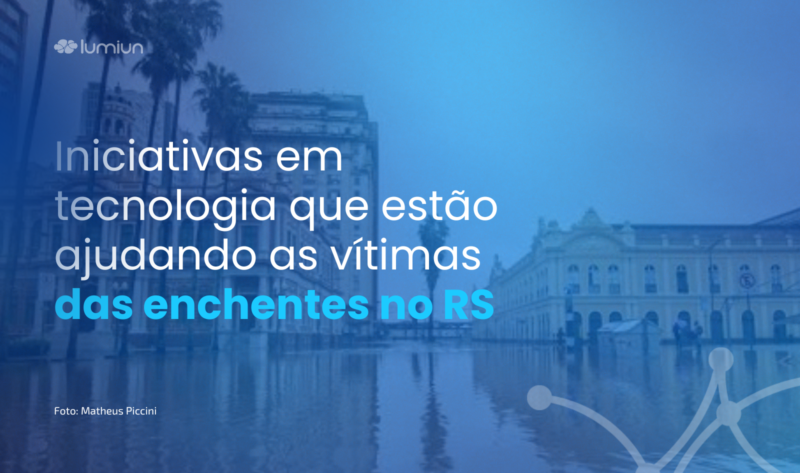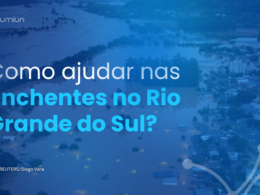Floods in Rio Grande do Sul have become a recurring challenge, but technology is playing a crucial role in mitigating their impacts.
The integration of advanced technologies is transforming the flood response in Rio Grande do Sul, saving lives and reducing damage. As these technologies continue to evolve, the ability to manage and mitigate natural disasters will become even more efficient.
In this article we will present how floods have affected the state of Rio Grande do Sul, and how technology has helped at this very sad time for the southern region of the country.
How the floods affected Rio Grande do Sul
Floods are devastating natural disasters that frequently affect different regions of the world, causing material damage, loss of life and significant socioeconomic impacts. In the state of Rio Grande do Sul, it was no different. Since April 27th, the state has faced the biggest flood in its history , leaving entire communities in an emergency situation.
According to the Civil Defense , issued on Tuesday, the 21st, there are 464 municipalities affected, 581 thousand homeless, 72 thousand people in shelters, 2.3 million people affected and 161 deaths. Causing widespread damage, flooding urban and rural areas, destroying homes, interrupting electricity supplies and damaging drinking water supplies. The magnitude of the floods highlighted the urgent need for effective measures to confront and deal with their consequences.
The impacts of the floods in Rio Grande do Sul are already greater than Hurricane Katrina that hit New Orleans (Louisiana), in the United States, in August 2005. According to information, in New Orleans the total number of flooded roads was 2.4 thousand kilometers, while in Rio Grande do Sul the flooding reached a total of 3.8 thousand kilometers. In addition to the fact that many municipalities in the southern state of the country no longer exist, it is not known how many cities will need to be relocated.
Faced with the scenario faced, a wave of solidarity emerged across the country, the population began to mobilize to help those who needed it most, both in the form of rescues, donations, and the creation of technologies that would help in this difficult and sad time. for the state of Rio Grande do Sul. In the midst of this adversity, technology has played a crucial role, offering innovative solutions to mitigate the effects of this natural disaster.
The biggest flood faced by the state of Rio Grande do Sul was in 1941 , 83 years later the state faced one of the biggest floods in its history on May 8th. In 1941 the water reached 4.76m above normal, in 2024 the water reached 5.3m above normal. Four of the five biggest recorded floods have occurred in the last eight years. But none had surpassed, until now, that of 1941.
How technology is helping with the floods in Rio Grande do Sul
It is not new that technology has helped with floods. In many countries around the world, technology is an ally in preventing natural disasters. As in Norway, an artificial intelligence tool uses public administration data to predict , up to seven days in advance, which floods will occur, which roads will become impassable, which public services will be paralyzed and where people should go.
Additionally, there are companies, startups and government initiatives focused on developing technologies to prevent natural disasters, remedy their impact and recover affected locations and populations. Creating an ecosystem of multilaterally generated information that contributes to the quality and response time of authorities in the face of critical situations.
In recent years, Rio Grande do Sul has faced severe floods that cause great damage. Technology has emerged as a vital ally in dealing with these natural disasters. Several innovations are being used to mitigate the impacts of flooding and improve the response of authorities and affected communities.
Real-time monitoring systems, such as water level sensors and early warning systems, have allowed authorities to predict and respond more quickly and efficiently to imminent floods. Furthermore, drones equipped with high-resolution cameras have been used to map flooded areas, identify victims in difficult-to-access locations and assist in rescue operations.
The integration of advanced technologies is helping the way Rio Grande do Sul faces floods. Based on analysis, it is possible to improve management and understand patterns associated with events and phenomena, in addition to working on interventions to prevent people from becoming stranded and at risk of death due to high water levels.
Artificial intelligence, drones, mobile apps, big data and IoT are providing powerful tools for predicting, monitoring and responding to disasters. They are also essential for improving the accuracy of early warning systems.
Technology initiatives that are helping flood victims in Rio Grande do Sul
The floods in Rio Grande do Sul have caused major challenges, but several technological initiatives are providing vital support to the victims.
Online platforms and mobile applications have been used to facilitate communication between rescue authorities and affected residents, allowing for the registration of distress calls, the sharing of information about shelters and emergency services, and the coordination of evacuation operations.
Furthermore, technology has been fundamental in providing health services and humanitarian assistance to affected communities. Below, we highlight some of these innovations that are making a difference in the floods in Rio Grande do Sul.
Monitoring and Alerting
AI and IoT-based systems and monitoring are used to predict floods and monitor river levels in real time. IoT-connected sensors provide continuous data on river conditions, allowing authorities to issue early and accurate warnings.
Apps are providing real-time alerts about flood risk. These apps use meteorological and hydrological data to notify users of the need to evacuate and provide information about safe routes and available shelters.
Rescue and Assistance
Drones equipped with high-resolution cameras are being used to map affected areas, identify victims and assess damage. These devices allow a comprehensive and immediate view of flooded regions, facilitating the coordination of rescue efforts.
Digital platforms are helping to coordinate volunteers and distribute resources. These tools make it easier to organize rescue teams, allocate resources, and communicate between different aid agencies and organizations. Here are some initiatives that were created to help with the flooding in Rio Grande do Sul.
- Lost person: is an AI solution that helps locate missing people. The platform also provides information about shelters, facilitating access to essential resources.
- Help RS: Allows anyone with internet access to report emergency situations via the website or WhatsApp.
- Pet RS: Using the form, the owner registers their lost animal, using good quality photos and filling in specific fields and adding a contact WhatsApp. Through this, it is possible to gather information to find domestic animals that ended up lost during heavy rains.
- SOS RS: Application developed to organize and distribute supplies, as well as coordinate volunteers during floods in Rio Grande do Sul.
3D printers were used for rescue buoys, using the printer and two-liter PET bottles, it was possible to create the buoys, to facilitate rescue between flooded points, in conditions without currents, for transporting people and animals in flooded areas.
Communication technology
During a flood, communication is crucial. Advanced communications technologies, such as sensor networks and SMS alert systems, ensure that information quickly reaches people at risk. These technologies enable a coordinated and efficient response, reducing reaction time and potentially saving lives. Among them are:
Collective action by telephone operators
Telephone operators opened their networks to roaming, allowing pre- and post-paid customers to connect to the internet for free, regardless of the operator of origin, to guarantee connectivity amid the floods in Rio Grande do Sul.
Amazon Satellite 1
The images produced by Amazonia 1 help with continuous and detailed monitoring, allowing an accurate assessment of damage, becoming a vital resource for the management of natural disasters.
Starlink antennas for isolated areas
Starlink antennas offer a solution for providing internet via satellite in remote locations in Rio Grande do Sul. They are essential for reestablishing communication at Civil Defense, Public Security, health units, schools and essential public services.
Post-disaster support
Big Data Analytics, the analysis of large volumes of data is helping to understand flood patterns and develop mitigation strategies for the future . With this information, authorities can make more informed decisions about urban planning and water resource management.
The Spanish company Indra has a project called EO4SD that focuses on the use of satellites to monitor potentially sensitive regions. Using Big Data and Analytics, information is gathered and the analysis of natural disasters, such as floods or landslides, gains agility and efficiency.
Smart infrastructure projects are being implemented to improve communities' resilience to flooding. This includes drainage systems, AI-controlled dams, and the construction of dikes in vulnerable areas.
During the rains that occurred in 2022, in Petrópolis (RJ), the city hall teamed up with the startup iNeeds System, to monitor rocks in risky locations , the sensor monitors any movement of the rock, and captures landslides in the surrounding area and thus information are sent in real time to Civil Defense.
How technology can contribute to the next natural disasters
As we face increasingly complex challenges related to climate change and extreme events, it is critical to continue investing in innovative technological solutions to strengthen our resilience and ability to respond to natural disasters .
In the future, we can expect significant advances in areas such as artificial intelligence, big data analytics and the internet of things (IoT), which will be essential for improving the accuracy of early warning systems, optimizing resource management during crises and facilitating post-crisis recovery. -disaster.
Technology is available to both public authorities and citizens, which can contribute to minimizing impacts on cities. Technology and data must be used to minimize the impacts of natural disasters.
This makes it possible to improve management and understand patterns associated with events and phenomena, in addition to working on interventions to prevent people from becoming stranded and at risk of death due to floods.
Technological advancement offers powerful tools to predict, respond to, and recover from natural disasters, potentially saving lives and reducing damage . As these technologies continue to evolve, the ability to manage crises and protect vulnerable populations will become increasingly effective.
Help Rio Grande do Sul
The state of Rio Grande do Sul is facing the worst flood in its history, many families have lost everything, and now the time has come for reconstruction. To help safely, on our blog you will find the article “ Floods in RS: Support for Campaigns and Alert against Scams ” in which you will find serious campaigns that you can donate to safely, without falling for scams.
As the water began to recede, many families need help cleaning their homes. Using the “Meu lar de Volta” , you can ask for help or apply as a volunteer to help clean homes.
Together we can make a difference for Rio Grande do Sul!









